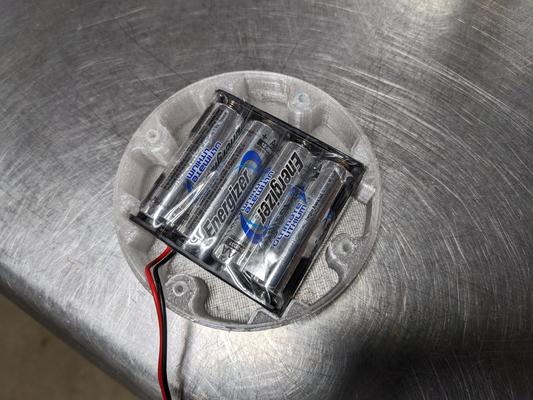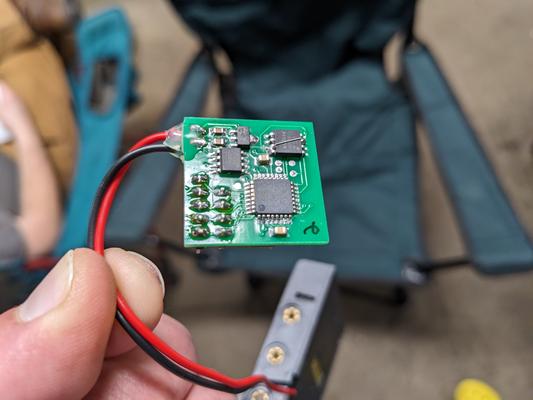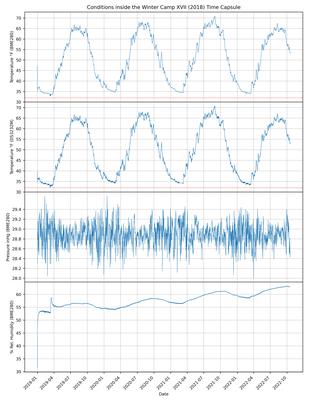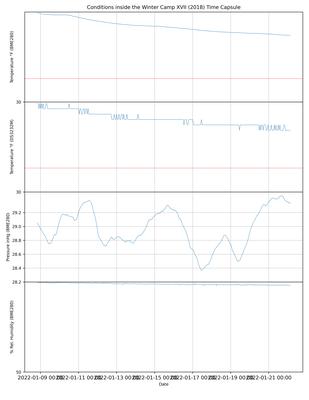
2024-01-02 | [envilog]
previous: 3 year update
This is part of my environmental logger project originally posted on hackaday.io
Welcome back everyone! The 5 year update I'm sure you've been anxiously waiting for is finally here, because just a few days ago I was able to recover the oldest unit from the time capsule where it was buried 5 years ago.
As a reminder, this project was constructed for a semi-local annual event I attend, where every year, we bury a time capsule. The capsules are staggered, so every year, there's another capsule from 5 years previous to retrieve and examine. The contents of these are the usual time capsule things like predictions about the future, pictures, and old newspapers, but occasionally someone will throw in a pack of Skittles or beef jerky or something to see how it fares, with results ranging from "mostly fine" to "this tastes like mold smells".
Anyways, a time capsule is usually a fairly passive thing, where mostly nothing happens until the capsule is opened. This is how it has been for almost every time capsule ever constructed, and the same for the past 30 or so years of our local tradition. Unless mold is forming, there's nothing active going on in there. What if you could wind a clock and have it still be ticking 5 years later? Nobody really knows what happens inside them for the intervening 5 years that they are buried, either. Do they freeze solid in winter? How stable is the inside environment? Sometimes we open them to find that they have taken in water - when did this happen? Immediately or after some time? That's what I was really trying to figure out.
It occurs to me that I've never uploaded a picture of one of our time capsules, so here's one of them:

This is not the usual design - most of the capsules are a 4" PVC with one end having a threaded plug for easy reuse. In this version, the 6" ends are simply pushed on and held by friction, with the seams sealed with tape. For either design, the tube is filled, sealed, and then buried at the top of a large hill, usually about 2 feet underground. The tubes do not contain desiccant.
The board installed in 2018 had a 3D printed holder, and used four Lithium/Iron Disulfide AA batteries, which are supposed to have an extremely long shelf life and very wide operating temperature. Upon recovery, two of the cells measured in at 0 volts, one at about .7V, and one still at 1.5V. I'll hang on the the one "good" battery to see how much power is really left in there. I apparently wrapped them in packing tape just in case they leaked, which they did not.


Another thing I noticed was that there is some flux present on the back of the board. Leaving flux can contribute to increased current draw, as it acts like a very high resistance. I'm not sure why this wasn't cleaned off - perhaps this contributed to the dead batteries.

Ok, so how long did it last? Well, first I had to make something that would show me the data after it was dumped out over the serial port. I always found working with plots in Matlab confusing, and now that I'm out of school I use python's MatPlotLib instead, and it's also confusing. Is satisfying when you finally get it right though; here it is:

Actually, I already messed up; it's supposed to say "Winter Camp XLII".
Looks like it lasted a bit over 3.5 years; 33471 hourly samples. I do have a control unit which I check up on once a year; it too was dead this July after 35553 hourly samples. Perhaps my lifetime calculation are a bit off, and I'll need to install a bigger battery next time. Current life is kind of ok for this part of the project - since the time capsules are staggered by 1 year, there should always be coverage, even if one unit fails.
I have to believe the temperature readings are fairly accurate, since I have two sensors for that which agree quite well (the BME280 and the internal thermometer in the DS3232M real time clock). Looks like the capsule gets down to just above freezing (the red line) in the winter, and goes up to a cool 65F in summer. Very reasonable.
How about the barometric pressure? It seems to vary widely, not what you would expect if the tube was really sealed. Maybe there is a pinhole leak, or maybe the entire PVC tube compressed and shrank under the pressure of the atmosphere. I'm no meteorologist, so let's take a look at another BME280 that I have running in my home system, to see what might be a typical year of measurement:

Don't try to correlate the above, it's from a different time period in a different part of the state, at probably a different altitude. Note the range of measurements though, they do see similar to what we see from the logger, so I'd have to say that the pinhole leak/non-airtightness theory is plausible.
Remember that volcano that exploded a couple years ago? I went looking through the data to see if it was there, as some people could actually see the pressure wave from it affect their barometers. Here's roughly a week of data. I didn't bother to format the graph correctly, but each grid line here is two days, and January 15, 2022 is about in the center. Personally, I don't see it - If I didn't know a volcano exploded that day I'd certainly have no reason to suspect there was one. An hour per sample probably is a bit too slow to have seen the pressure wave go by - I think it happened in minutes instead, and changed the pressure by only a few 0.01 inches. However, this graph goes to show how readily the capsule is affected by pressure, with a week's change of about 1" Hg (about .5 PSI) clearly visible. We'll see what happens next year with the screw-cap capsule. It's also easy to see here the difference in precision between the BME and RTC thermometers.

Lastly is the humidity. Once the capsule was sealed, the internal humidity rose up from the dry air it was sealed in to a bit over 50%. Also, you can see that over a few years time, the humidity further increased. Further evidence that the capsule is not fully sealed. Something interesting happened in March of 2019. Here's a closeup of that time:

I'm not quite sure what to make of this - it was pretty cold at this time so this could be some kind of freeze-thaw situation that resulted in the cap sliding a little bit. This is only my best, uneducated guess. What do you think about it?
All in all, I think this project is off to a good start. It will only be a year until the next one of these is dug up, and all current capsules have one, so it should be an update every year. It's interesting to think about what has changed in the past 5 years for me - this was my very first SMD project, and these days I regularly design PCBs with SMD components, and often work with the very tiny 201 packages and tiny BGA chips - some personal, and some as part of my day job.
Continued thanks to the Cave Perl Project, which partially inspired this one 5 years ago, and celebrated their own 10 year anniversary last year. Their 10 year report on waterproofing is certainly worth a re-read when I place the next of these loggers next time.
Also, this design is not the current one. In 2022 I redesigned the PCB (but apparently forgot to write a log about it) to accept a bunch of other sensors, of which so far I have only tried the BME280 + another temperature sensor. Details for this current version are on Github. Here's a picture of a couple I built last year, for installation back into the time capsule for another round.
